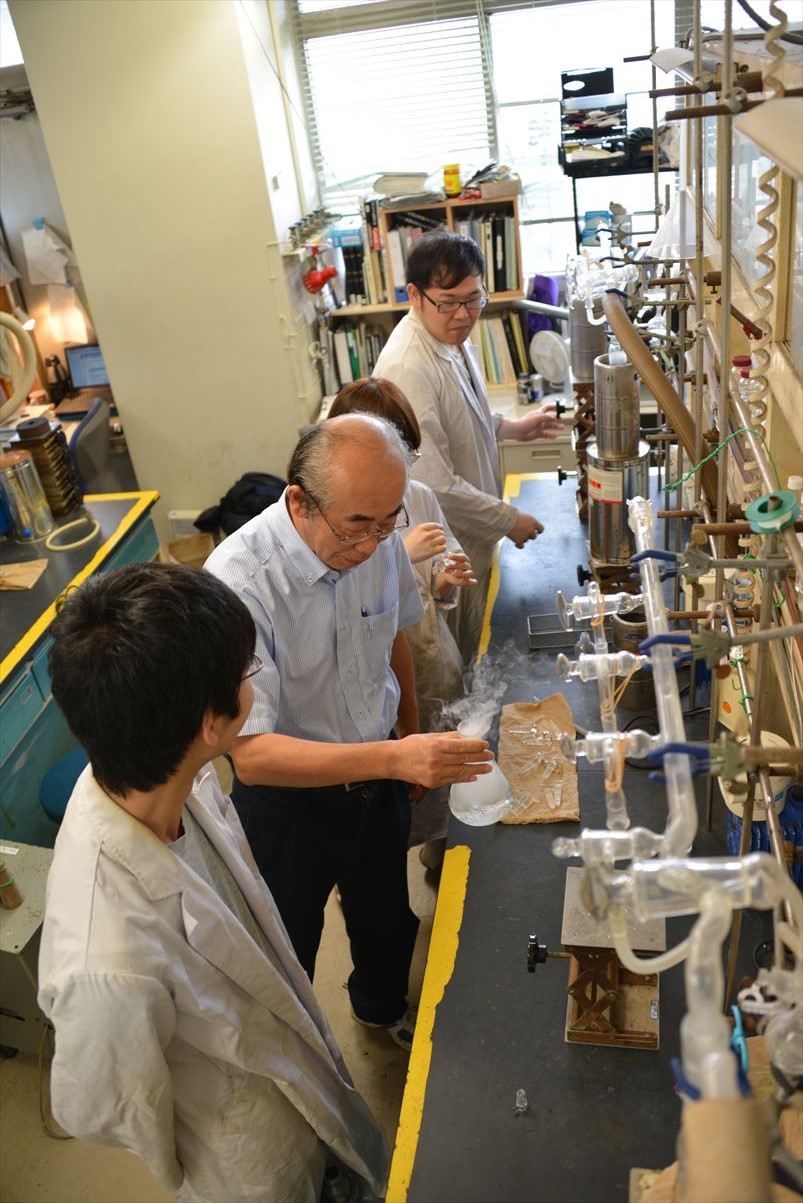TSUKUBA FRONTIER
#03 One Molecule Can Change the World: Fundamental Chemistry Is a World Full of Opportunities
Silicone is an indispensable part of contemporary society, from generic products such as cushioning materials, lubricants and coatings to high-performance materials such as electronic components and medical devices. The element which is key to this is silicon. Research into organic silicon compounds has led to breakthroughs so significant that chemical bond theory textbooks have had to be rewritten, and even now, Professor Sekiguchi is continuing to make the most of these new possibilities.
Professor SEKIGUCHI Akira, Faculty of Pure and Applied Sciences

■ Silicon - a ubiquitous element
In the Earth's crust, the space all living things inhabit, silicon is the second most abundant element, exceeded only by oxygen. However, it is only in the last 100 years or so that humans have been able to use silicon effectively because the chemical bond between silicon and oxygen is extremely tight and very difficult to break. Nevertheless, applications increased exponentially once a method for obtaining monocrystal silicon had been established and the versatile organic silicon compound had been synthesized. Silicon is now used in solar power generation, space shuttles, sportswear, construction materials, electronics and more, all of which enrich our lives immeasurably.
■ The silicon-silicon triple bond took 23 years to achieve
A glance at the periodic table of elements will show that silicon is in the same group as carbon (Group 14). Generally, elements in the same group have similar chemical properties, but silicon and carbon exhibit completely different behaviors. One of these is multiple bonding. Carbon forms double and triple bonds to generate ethylene and acetylene. However, because silicon has a large atomic radius and a long bond length, it was long thought that it could not form multiple bonds.
The breakthrough formation of the first silicon-silicon double bond was achieved in 1981 in the US, and this triggered the race towards creating the first silicon-silicon triple bond (disilyne). A triple bond is a chemical bond which is the first step on the journey towards synthesizing a range of compounds, such as polymers and cyclic compounds. The inclusion of silicon in these vastly expands the possibilities for developing new materials.
It was Christmas 2003, 23 years later, that this research finally bore fruit. Until then, it was thought that the interatomic electron distribution was symmetrical, as seen in acetylene, but it appeared that this was rare, and it was the concept of asymmetry which had originally been proposed. This was proven when stable disilyne was synthesized in experiments.
The formation of disilyne was reported around the world in chemistry journals and even in general newspapers such as the New York Times, as a discovery which totally overturned conventional chemical bond theory. This achievement rewrote chemistry textbooks and became a new milestone in the history of chemical research. A change in a basic concept such as chemical bonding is momentous in that it affects research in all related fields.
■ A new type of storage battery

Research into disilyne synthesis has provided important findings regarding the process itself. It is a synthesis of germanium and silicon cation (positive ion). The possibility of their existence had been discussed animatedly since the 1980s, and publication of the research in a science magazine in 1996 put an end to the debate.
When a cation receives one electron it becomes a radical, and when a radical receives one electron it becomes an anion (negative ion). In the case of silicon, this reaction occurs easily and reversibly through electron interaction, and all these states can exist stably. At present, Prof. Sekiguchi is collaborating with corporations to find ways to use these properties in the development of a new type of storage battery (radical battery).
Lithium ion batteries used in computers and hybrid cars can be used for a long time, but there is a danger that they may catch fire if the output is increased. In silicon radical batteries, electron movement maintains the reaction so they can be charged quickly and large outputs can be achieved safely.
■ The university is a place for sharing
Fundamental chemistry is fascinating as just one molecule can change the world. One molecule can create something that had previously never existed. Just as happened with nylon and silicone, an unlimited number of applications can be discovered and dramatic technical innovations can be achieved.
However, this cannot be achieved by one person alone. It is essential that people involved in fundamental research collaborate with people working in fields in which their research findings can be utilized. Without doubt chemistry itself is academically interesting, but closing oneself off in one's own research field prevents contact with new knowledge and ideas, and precious opportunities may be lost.
Seen in that light, the impact of students is indispensable. Even as a researcher himself, Prof. Sekiguchi feels that there are many things to be learnt from students. A university is a place in which teachers and students grow together. Knowledge is shared rather than imparted. If there was one piece of advice to be given to students, it is this: what is written in the textbook could be upturned at any time.
Article by Science Communicator at the Office of Public Relations


